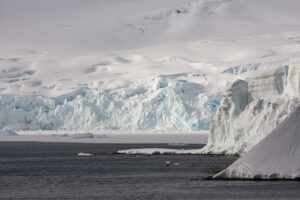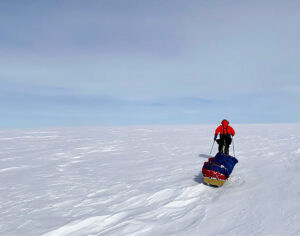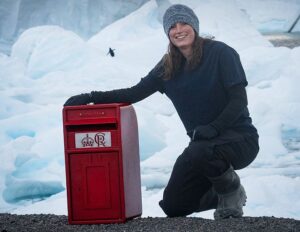The Antarctic summer is shaping up to be the busiest season since 2011-12. A few familiar names and a swathe of new South Pole hopefuls are gearing up to begin in November or December.
Let’s break down the expeditions that have been announced so far.
Crossings
There are three variations of Antarctic crossings this season. So far, no one is attempting a full crossing of the continent.
Gareth Andrews and Richard Stephenson
Australian Gareth Andrews and Kiwi Richard Stephenson are aiming for a slightly extended version of the journey undertaken by both Colin O’Brady and Lou Rudd in 2018. They’ll set off from northern Berkner Island, head to the South Pole, then make for the nearest “coast”, the Ross Ice Shelf, to wrap up their 2,023km route. However, their endpoint is not a true coastal finish, as they plan to end their journey at the inner edge of the permanent ice shelf.
The pair had originally branded their expedition as “The Last Great First”, a title that comes up once every couple of years. Instead, they have sensibly rebranded it as Antarctica 2023. Their crossing is certainly not the last great first, though it would be an impressively long journey.

Andrews and Stephenson’s route map. Photo: Antarctica 2023
As they are still prominently advertising their expedition as unsupported, it will be interesting to see whether they use the graded, marked road from the South Pole to the Ross Ice Shelf. The road, used by polar scientists, eliminates the need to navigate and provides a smooth run without crevasses or the bumpy sastrugi that skiers dread.
Preet Chandi
Last year, Preet Chandi finished her 1,126km solo expedition from Hercules Inlet to the South Pole in an impressive 40 days. This year, she returns for an even longer slog — a solo crossing of approximately 1,600km. Presumably, like last year, Chandi is setting off from Hercules Inlet to the South Pole. From there she will continue to the Ross Ice Shelf.
Chandi is flying to Chile soon and plans to set off with a 120kg pulk in early November.

Preet Chandi during her 2021-2022 Antarctic expedition. Photo: Preet Chandi
Australian Defence Force
A team from the Australian military (both veterans and serving personnel) will also take on a variation of the same crossing. The six-person team consists of expedition leader Emily Chapman, Vincent Carlsen, Jack Forbes, Sean Taylor, Kelly Kavanagh, and Tim Geronimo.
They hope to complete their Messner Start-South Pole-Ross Ice Shelf route in 72 days.
Hercules Inlet to the South Pole
A host of teams and solo skiers will ski from Hercules Inlet to the Pole.
Mikko Vermas and Tero Teelahti will set out on an unsupported expedition, each pulling 110kg sleds. They hope to cover the 1,130km from Hercules Inlet to the Pole in 40 to 50 days. The pair have some experience, having previously skied to the North Pole in 2006.
Canadian Caroline Cote has set herself an ambitious goal. Cote will travel solo and unsupported, hoping to break the women’s speed record to the Pole from Hercules Inlet. Swede Johanna Davidsson holds the record, set in 2016, with a time of 38 days and 23 hours.
Cote joins at least one more speed record hopeful, Wendy Searle. Searle had a crack at the Hercules Inlet to South Pole speed record in 2020 but missed out on the women’s record by about three days.
Other solo skiers include Polish adventurer Mateusz Waligora, Norwegian Hedvig Hjertaker, and Scot Benjamin Weber. Nick Hollis will also set out from Hercules Inlet but it is unclear if he will ski alone.
Guided groups from the Messner Start
Inspire22 is a 10-person team composed of a mixture of British military personnel and civilians, guided by Canadian Devon McDiarmid. They bill their expedition as primarily a scientific endeavor to “explore the metabolic cost of sustained polar travel”.

Borge Ousland’s company will guide a group of young explorers. Photo: Vincent Colliard
Polar legend Borge Ousland’s company, Ousland Explorers, will be guiding a small team from the New Zealand Antarctic Heritage Trust. Bengt Rotmo will guide Kiwi’s Laura Andrews and Mike Dawson (a former Olympian), and Norwegian Marthe Brendefur. The Trust selected the three team members from hundreds of hopefuls aged between 18 and 35 who applied.
Wrapping up the Messner Start guided groups, two Antarctic Logistics & Expeditions (ALE) teams will also set out on the roughly 1,000km route to the Pole.






